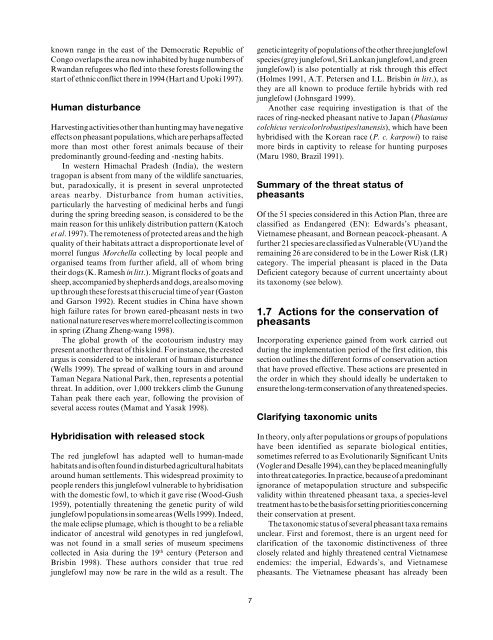Pheasants: Status Survey and Conservation Action Plan ... - IUCN
Pheasants: Status Survey and Conservation Action Plan ... - IUCN
Pheasants: Status Survey and Conservation Action Plan ... - IUCN
You also want an ePaper? Increase the reach of your titles
YUMPU automatically turns print PDFs into web optimized ePapers that Google loves.
known range in the east of the Democratic Republic of<br />
Congo overlaps the area now inhabited by huge numbers of<br />
Rw<strong>and</strong>an refugees who fled into these forests following the<br />
start of ethnic conflict there in 1994 (Hart <strong>and</strong> Upoki 1997).<br />
Human disturbance<br />
Harvesting activities other than hunting may have negative<br />
effects on pheasant populations, which are perhaps affected<br />
more than most other forest animals because of their<br />
predominantly ground-feeding <strong>and</strong> -nesting habits.<br />
In western Himachal Pradesh (India), the western<br />
tragopan is absent from many of the wildlife sanctuaries,<br />
but, paradoxically, it is present in several unprotected<br />
areas nearby. Disturbance from human activities,<br />
particularly the harvesting of medicinal herbs <strong>and</strong> fungi<br />
during the spring breeding season, is considered to be the<br />
main reason for this unlikely distribution pattern (Katoch<br />
et al. 1997). The remoteness of protected areas <strong>and</strong> the high<br />
quality of their habitats attract a disproportionate level of<br />
morrel fungus Morchella collecting by local people <strong>and</strong><br />
organised teams from further afield, all of whom bring<br />
their dogs (K. Ramesh in litt.). Migrant flocks of goats <strong>and</strong><br />
sheep, accompanied by shepherds <strong>and</strong> dogs, are also moving<br />
up through these forests at this crucial time of year (Gaston<br />
<strong>and</strong> Garson 1992). Recent studies in China have shown<br />
high failure rates for brown eared-pheasant nests in two<br />
national nature reserves where morrel collecting is common<br />
in spring (Zhang Zheng-wang 1998).<br />
The global growth of the ecotourism industry may<br />
present another threat of this kind. For instance, the crested<br />
argus is considered to be intolerant of human disturbance<br />
(Wells 1999). The spread of walking tours in <strong>and</strong> around<br />
Taman Negara National Park, then, represents a potential<br />
threat. In addition, over 1,000 trekkers climb the Gunung<br />
Tahan peak there each year, following the provision of<br />
several access routes (Mamat <strong>and</strong> Yasak 1998).<br />
Hybridisation with released stock<br />
The red junglefowl has adapted well to human-made<br />
habitats <strong>and</strong> is often found in disturbed agricultural habitats<br />
around human settlements. This widespread proximity to<br />
people renders this junglefowl vulnerable to hybridisation<br />
with the domestic fowl, to which it gave rise (Wood-Gush<br />
1959), potentially threatening the genetic purity of wild<br />
junglefowl populations in some areas (Wells 1999). Indeed,<br />
the male eclipse plumage, which is thought to be a reliable<br />
indicator of ancestral wild genotypes in red junglefowl,<br />
was not found in a small series of museum specimens<br />
collected in Asia during the 19 th century (Peterson <strong>and</strong><br />
Brisbin 1998). These authors consider that true red<br />
junglefowl may now be rare in the wild as a result. The<br />
genetic integrity of populations of the other three junglefowl<br />
species (grey junglefowl, Sri Lankan junglefowl, <strong>and</strong> green<br />
junglefowl) is also potentially at risk through this effect<br />
(Holmes 1991, A.T. Petersen <strong>and</strong> I.L. Brisbin in litt.), as<br />
they are all known to produce fertile hybrids with red<br />
junglefowl (Johnsgard 1999).<br />
Another case requiring investigation is that of the<br />
races of ring-necked pheasant native to Japan (Phasianus<br />
colchicus versicolor/robustipes/tanensis), which have been<br />
hybridised with the Korean race (P. c. karpowi) to raise<br />
more birds in captivity to release for hunting purposes<br />
(Maru 1980, Brazil 1991).<br />
Summary of the threat status of<br />
pheasants<br />
Of the 51 species considered in this <strong>Action</strong> <strong>Plan</strong>, three are<br />
classified as Endangered (EN): Edwards’s pheasant,<br />
Vietnamese pheasant, <strong>and</strong> Bornean peacock-pheasant. A<br />
further 21 species are classified as Vulnerable (VU) <strong>and</strong> the<br />
remaining 26 are considered to be in the Lower Risk (LR)<br />
category. The imperial pheasant is placed in the Data<br />
Deficient category because of current uncertainty about<br />
its taxonomy (see below).<br />
1.7 <strong>Action</strong>s for the conservation of<br />
pheasants<br />
Incorporating experience gained from work carried out<br />
during the implementation period of the first edition, this<br />
section outlines the different forms of conservation action<br />
that have proved effective. These actions are presented in<br />
the order in which they should ideally be undertaken to<br />
ensure the long-term conservation of any threatened species.<br />
Clarifying taxonomic units<br />
In theory, only after populations or groups of populations<br />
have been identified as separate biological entities,<br />
sometimes referred to as Evolutionarily Significant Units<br />
(Vogler <strong>and</strong> Desalle 1994), can they be placed meaningfully<br />
into threat categories. In practice, because of a predominant<br />
ignorance of metapopulation structure <strong>and</strong> subspecific<br />
validity within threatened pheasant taxa, a species-level<br />
treatment has to be the basis for setting priorities concerning<br />
their conservation at present.<br />
The taxonomic status of several pheasant taxa remains<br />
unclear. First <strong>and</strong> foremost, there is an urgent need for<br />
clarification of the taxonomic distinctiveness of three<br />
closely related <strong>and</strong> highly threatened central Vietnamese<br />
endemics: the imperial, Edwards’s, <strong>and</strong> Vietnamese<br />
pheasants. The Vietnamese pheasant has already been<br />
7
















